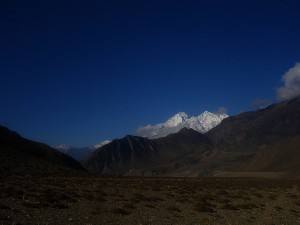 It’s best to leave Tukuche in the morning before the wind picks up (some time around eleven).
It’s best to leave Tukuche in the morning before the wind picks up (some time around eleven).
Blowing in through the Annapurnas and Dhaulagiri, it sends a fine mist of grey, grainy dust swirling around you.
Going in this direction isn’t so bad, as you have the wind in your back. Those coming in from Jomsom though bear the full brunt of it.
I turn around into the wind for an instant, and a fine dust fills my eyes and nostrils and, quite literally, takes my breath away.
The local shops profit on this aspect of the local geography by selling brightly coloured face masks, with the result that the route is peppered with tourists that all look as if they are making their multi-coloured way to some bizarre surgical performance or are about to launch a raid on the local distillery.
I make a note to buy one myself, because we will have to walk back this direction when we return from Muktinath.
All around us is desert and arid, dusty, brown and yellow cliffs. Somehow this scenery makes the snow capped peaks seem more distant, as if they are a mirage. The two things seem so incompatible – the fresh, high, white peaks and this dry dusty river valley. How is it possible to apparently be in two so different places at once?
In the wide open space the sounds seem to rise up hauntingly, so you hear things long before you see them, despite the wind.
In a sparse, immense valley I hear bells but cannot make out any forms in the distance. In fact, it’s hard to know where any sounds are coming from. It’s as if there are no edges to the space, no horizons. Just this limitless, vast space.
Then I make out a herd of goats, their white shapes suddenly materialising from the dust, followed by the herders on mules. They rise up from the river valley, come into view, then pass by and seem to fade away, all within the space of a few minutes.
It’s very disconcerting. For a city dweller, space such as this, the sheer emptiness of the place, can be a lonely experience.
I stay close to the rest of the group for solace but every now and then the distant hum of a motorbike filters through and sounds so very far away.
How do people manage to live here? is all I can wonder.
Pulling into Marpha just two hours or so after leaving Tukuche, is therefore something of a relief.
With its little shops and guesthouses, its winding alleyways feel bustling and vibrant. A haven of activity among all that emptiness.
The narrow streets and the thick walls of the whitewashed houses offer protection from the wind, so much so that you can hear the water as it trickles under the flagstone paving, carrying the dust and waste away from the town and down to the river.
There’s something soothing about it. Not just the sound of the water flowing, but what it represents. The fact that out here, in this high desert valley, this little feat of human engineering has been accomplished.
My sense of isolation diminishes when I hear it and I am at ease again, ready to relax over lunch and spend the rest of the day pottering about in the guesthouse reading and playing cards.
We could walk on to Jomsom, after all we’ve only been going for a few hours and the day is young, but there’s something so pleasant about Marpha, with its maze of streets, its lonely location, its shops filled with store keepers who seem more intent on playing some unfathomable board game than hustling tourists, that makes us decide to stay put and hang around for a while.
I guess it’s the snugness of it all. The warmth and comfort of the streets. There’s an enveloping and welcoming comfort about Marpha that is simply impossible to resist.
So we stay, all thoughts of wind and dust and isolation forgotten in the comfort that only a village such as this could bring …